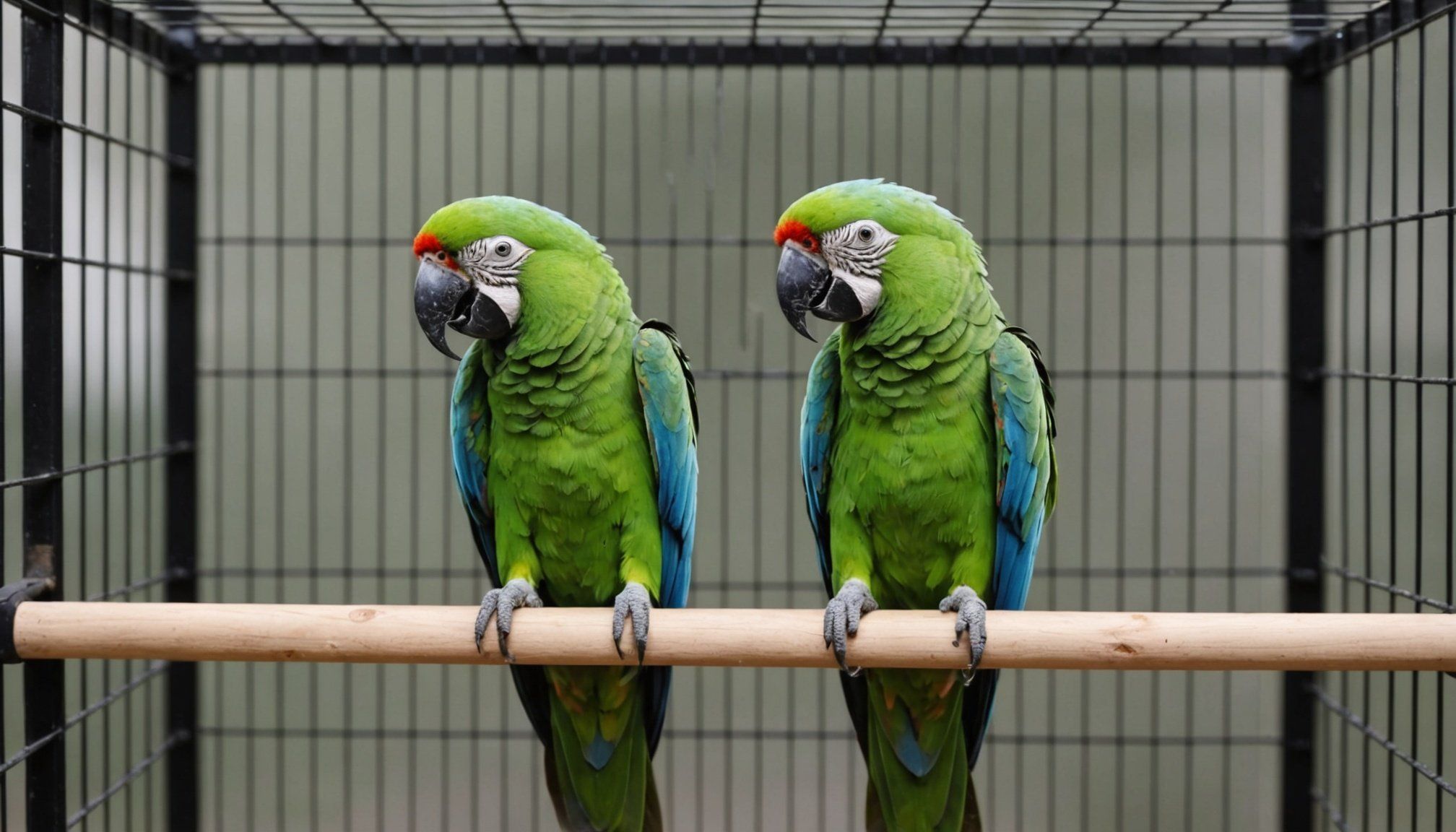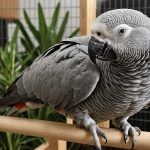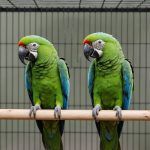Understanding the Needs of a Lone Parrot
Parrots are highly intelligent creatures that naturally thrive in social environments. Understanding parrot care involves recognizing the complexities of their social dynamics. In the wild, parrots often live in flocks, engaging in intricate bird behavior crucial for their well-being. For a solitary parrot, the absence of flock interaction can lead to stress and behavioral issues. The importance of social interaction and companionship cannot be overstated.
A solitary parrot requires tailored care to address its unique needs. Without interaction, these birds might exhibit behaviors such as excessive vocalization or feather plucking, indicating distress. Recognizing the signs of loneliness and addressing solitary parrot needs is vital for their mental health. Engaging in daily interactive play, training sessions, and shared routines can help mitigate feelings of isolation.
Have you seen this : Create a Spacious Sanctuary: Pro Tips for Welcoming Your Growing Maine Coon Kitten
Providing a nurturing environment involves understanding parrot care essentials. Investing time in learning about their social cues and responses is key to fostering a happy and emotionally balanced pet. Additionally, introducing new stimuli and varied activities can create a more fulfilling life for a lone parrot, enabling it to thrive even without a feathered companion.
Creating an Engaged Living Space
Ensuring a well-arranged parrot habitat setup is paramount for a parrot’s contentment. A stimulating environment is essential, incorporating elements such as bird toys and structures that promote physical and mental engagement. Variety in toys is key; look for items that offer texture, challenge, and interaction. When selecting toys, consider those that encourage foraging and problem-solving, as these stimulate the parrot’s natural instincts. Adding swings, ladders, and perches of different sizes can also contribute to a diverse and enriching space.
In parallel : Creating the Perfect Sanctuary: Expert Tips for Designing a Secure and Stimulating Environment for Your African Grey Parrot
Environmental enrichment isn’t just about the items themselves but also about how they are arranged. Providing ample space for movement and interaction transforms the parrot habitat setup into a dynamic locale. Ensure that toys and objects are rotated regularly to maintain interest and avoid monotony.
The layout should facilitate interaction and exploration, which are crucial for mental and physical health. Pay attention to how your parrot interacts with its environment. Rearranging toys and perches occasionally can help simulate the dynamic changes found in a parrot’s natural surroundings. Remember, an active setup promotes not just play but growth and curiosity in the parrot.
Enhancing Social Interaction
Socializing a parrot is fundamental to parrot socialization and fostering a strong bond. Effective training can transform interactive play into meaningful engagement. Start with training methods that are both engaging and rewarding, encouraging desirable behaviors through positive reinforcement. Bonding with pets can be deepened by maintaining a routine that includes regular play and handling sessions, crucial for building trust and security.
Effective Training Methods to Encourage Engagement
Focus on praise and small treats to motivate the parrot during training. These interactive play sessions help maintain interest, making learning fun. Incorporate commands that match your parrot’s natural instincts, such as mimicking or climbing, ensuring the activities are enjoyable.
Scheduling Daily Interaction and Playtime
Consistency is key; creating a daily schedule for interactive play assures the parrot receives enough attention and social stimulation. Balance is crucial—combine solo time with periods of contact to prevent over-dependence. Implement a variety of games to cater to the parrot’s need for mental and physical engagement, ensuring the bird remains active and content. A scheduled approach not only enhances bonding with pets but also supports a harmonious relationship.
Incorporating Mental Stimulation Techniques
Enriching a parrot’s environment with bird puzzles is pivotal for their mental and cognitive well-being. Interactive puzzles cater to a parrot’s need for problem-solving and natural curiosity, keeping them intellectually engaged and preventing boredom. Birds thrive on complexity and challenge, so consider incorporating a mix of shape-sorting puzzles, food-based challenges, and maze toys into their play routine.
Variety is essential in creating a stimulating environment. Develop a dynamic schedule that introduces new stimulation activities regularly. This could involve alternating between different types of puzzles and games throughout the week, ensuring the parrot stays interested and engaged. Aim to balance routine with excitement, providing both predictable and novel experiences.
When incorporating new activities, proceed gradually to avoid overwhelming the bird. Introduce new puzzle types slowly, allowing time for the parrot to become comfortable with each one. Begin with simpler tasks and gradually increase complexity to match their growing skills. Transitioning in this manner supports cognitive care, enabling the parrot to enjoy the process of exploration and learning, ultimately fostering a resilient and active mind.
Troubleshooting Common Enrichment Challenges
When caring for a solitary parrot, understanding and identifying parrot behavior issues are paramount. Parrots may exhibit stress through excessive vocalization or feather plucking, often indicating that their enrichment needs aren’t adequately met. Recognizing these signs early can guide adjustments in care to better address their unique needs.
Introduce new toys or activities gradually to prevent overwhelming the parrot. Begin with simple items and slowly increase complexity. This approach ensures successful transitions to new enrichment tools, boosting the parrot’s engagement with its surroundings.
Adjusting strategies based on an individual parrot’s personality is crucial. Some parrots may prefer puzzle toys, while others might enjoy climbing structures. Observing their reactions to different enrichment solutions can help tailor their environment and meet their specific preferences.
Create a rotating schedule for toys and activities to maintain interest and prevent boredom. Change out items regularly to simulate dynamic environments, keeping the parrot’s space lively and engaging. A well-observed parrot is a resilient one, responding positively to personalized adjustments in their care routine.
Resources for Parrot Owners
Navigating the world of parrot care becomes more enriching with access to quality resources. Recommended books, such as “A Parrot’s Fine World” and “The Parrot Companion,” provide comprehensive insights on parrot care and solitary parrot needs. These resources delve into topics like bird behavior and practical approaches to foster an engaged, healthy life for your feathered friend.
Online platforms like Parrot Haven and My Parrot Paradise feature expansive communities where parrot owners share experiences, advice, and recommendations. Engaging in such communities allows for the exchange of ideas and solutions, fostering a supportive community support environment that helps address any uncertainties or challenges faced in managing parrot health.
When it comes to product selection, brands like Creative Foragers and Feathered Friends stand out in delivering high-quality toys and habitat essentials. Their offerings emphasize sustainable and engaging solutions, further promoting bird behavior enrichment.
Staying connected with local avian communities by attending meetups or joining clubs can also enhance knowledge and social circles, offering a local support network and opportunities for shared learning. Such interaction nurtures both owner and parrot alike, fulfilling the solitary parrot needs.











